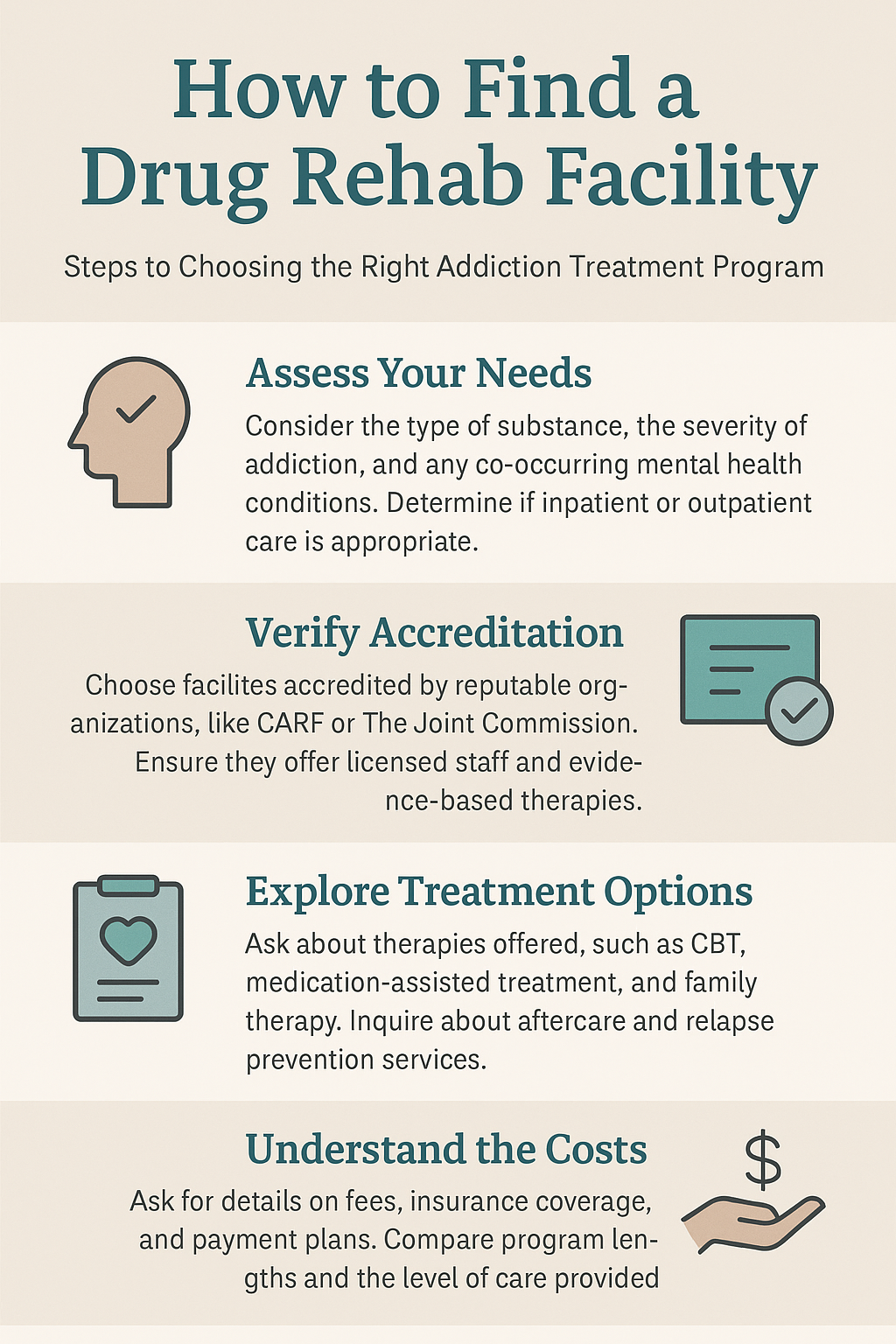
Choosing a drug rehab facility can be challenging, but an informed search ensures proper help. This article offers practical guidance on selecting a suitable program, whether for yourself or a loved one.
Sometimes, the entire process can feel overwhelming. You might not know where to start or what to prioritize. But with a step-by-step guide, you can break down the process into manageable parts. This article covers understanding personal needs, researching options, evaluating programs, and planning logistics. I hope these clear steps help you feel more confident in making a choice that fits your situation.
Step 1: Understand Your Needs and Goals
Before starting your search, it is essential to identify what you or your loved one truly needs. The right facility depends on factors like the type of substance use disorder, treatment intensity, and whether you need inpatient or outpatient care. Knowing your personal goals will help guide your decision. Having a clear vision of your specific needs narrows down the options and reduces the stress that often comes with making such a significant decision.
Questions to Ask Yourself:
- What type of treatment am I looking for? (Inpatient, outpatient, or specialized care)
- Which substances need to be addressed in the treatment plan?
- What is my budget, or what types of insurance do I have?
- How far am I willing to travel for treatment?
- Do I have a preference for a faith-based or a secular program?
Example Considerations:
- Seeking a program that offers both detox and therapy sessions.
- Looking for facilities accredited by recognized authorities.
- Finding a center with experience in the specific substance abuse issues involved.
Taking the time to list your needs and goals will make it easier to compare different rehab facilities. It can also help you explain your situation more effectively when seeking additional information or advice.
Step 2: Research Different Rehab Facilities
The next step is to gather information about the rehab centers available in your area or country. Today, numerous resources are available online, making it easier to compare options based on services, treatment methods, and success rates. This research lays the foundation for the subsequent steps of your evaluation.
How to Start Your Research:
- Search online directories and government websites that list licensed rehab facilities.
- Read review sites and testimonials to gain insight into patient experiences.
- Check each facility’s credentials and accreditations.
- Review the types of therapies and programs offered.
Pro Tip:
List potential rehab centers and note key details, including contact information, services provided, and any specializations that align with your needs. A detailed list can help you compare your options effectively and ensure nothing important is overlooked.
Step 3: Evaluate Treatment Approaches and Programs
Once you have a list of potential facilities, the focus shifts to understanding their treatment approaches and methods. Since each facility may offer different treatment programs, carefully consider how they align with your personal goals. The type of program available is one of the most important factors when making an informed decision about your care.
Treatment Methods to Consider:
- Cognitive Behavioral Therapy (CBT) – Often used for an array of substance abuse issues.
- Holistic Approaches – This may include yoga, meditation, and nutritional support.
- Medication-Assisted Treatment – Helps manage withdrawal symptoms and reduce cravings.
- Aftercare Planning – Very important for maintaining long-term sobriety.
Example:
If you value a balanced approach that considers mental, physical, and emotional rehabilitation, look for a facility that combines evidence-based therapies and holistic practices. This blend may be beneficial if you are seeking an all-in-one program that supports lasting recovery.
Step 4: Check Facility Credentials and Staff Expertise
Credentials and expertise are significant factors in ensuring a rehab facility can deliver the expected treatment outcomes. Accredited centers are generally held to higher standards regarding safety and quality of care. Confirming that the staff is experienced and adequately trained in addiction treatment provides additional confidence in your decision.
How to Verify Facility Credibility:
- Look for accreditation from recognized bodies.
- Examine staff credentials, such as licenses, certifications, and years of professional experience.
- Ask if the facility undergoes regular audits or quality assessments.
Additional Tips:
- Search for any complaints or disciplinary actions related to the facility.
- Consider contacting former patients when possible; their feedback can uncover details about the treatment environment that you might not learn online.
This step involves ensuring that you are entrusting a facility with a proven track record of providing safe and effective care.
Step 5: Consider Logistics and Budget
The next part of the process involves sorting out logistics. Rehabilitation facilities can vary considerably in terms of cost, location, and available amenities. Establishing a practical plan that covers these aspects is crucial before making your final decision.
Key Considerations:
- Cost and Insurance: Review your insurance coverage and explore available payment options.
- Location: Decide whether you need a facility close to home or if a more specialized program farther away might be a better choice.
- Accommodations and Amenities: Investigate the facility’s living conditions, meal plans, and extracurricular activities.
Example:
- Determine if there will be additional expenses, such as transportation or follow-up outpatient services.
- Ensure that the facility fits your budget while meeting your treatment needs.
This planning stage is crucial to prevent unforeseen issues from disrupting the recovery process.
Step 6: Visit or Communicate with the Facility
Whenever possible, visiting a rehab center or speaking directly with the staff can help clarify any uncertainties. This step provides you with firsthand experience of the facility’s environment, treatment style, and overall ambiance.
What to Look for During a Visit or Call:
- Cleanliness and overall condition of the facility.
- The team’s attentiveness and professionalism during your visit or call.
- How openly are treatment methods and success stories explained?
- Opportunities to learn about any family or individual support services provided.
Pro Tip:
Prepare a list of questions and consider bringing a friend or family member along for support. A second opinion can often help capture details that might be missed during your visit.
Step 7: Stay Informed and Follow Up as Needed
Finding a drug rehab facility is a significant decision; staying informed throughout the process is key. After initial research and visits, follow-up and additional questions are essential if any doubts remain. Treatment needs and personal goals can change over time, so maintaining an open dialogue with the facility will help keep you on the right path.
Tips for Ongoing Follow-Up:
- Request detailed information on the treatment plan and what to expect after completing the rehabilitation program.
- Stay in touch with facility staff to learn about their support for long-term recovery.
- Confirm the facility’s policies on client feedback and complaint resolution.
- Check periodically for any updates or improvements in the facility’s programs.
This continual reassessment ensures you make the best decision for current and future needs.
Step 8: Additional Considerations for a Successful Recovery
Beyond choosing a facility based solely on treatment methods and credentials, additional factors can significantly impact your long-term recovery. It is essential to think about the emotional and social aspects of rehabilitation. Often, facilities that offer extended counseling sessions, family therapy, and group support can make the difference between a temporary fix and lasting recovery.
In this phase, take time to explore how each center supports not only the physical aspects of addiction but also the emotional and psychological challenges that might arise during recovery. Look for programs incorporating family support, as involving loved ones in therapy can help strengthen recovery. Additionally, check whether the facility offers opportunities to reconnect with community resources, alumni groups, or local support networks after formal treatment concludes.
Moreover, the facility’s overall atmosphere should be considered. A calm and encouraging environment can be as important as the technical aspects of treatment. Checking in on these extra details can help ensure your transition into everyday life is as smooth as possible. Remember, recovery is an ongoing adventure that often requires more than just the initial treatment; it involves building a strong support network and accessing continuous resources for guidance.
Common Questions & Troubleshooting
What if I feel overwhelmed by the number of options?
It is entirely normal to feel overwhelmed. Try narrowing your search based on location, cost, and specific treatment methods. A well-organized list of criteria helps simplify the decision process and makes it easier to compare each option.
How do I know if a facility is the right fit?
- Trust your instincts. It might be worth exploring other options if something doesn’t feel right.
- Seek recommendations from medical professionals, counselors, or support groups.
- Don’t hesitate to ask tough questions during your visit or call.
I’m concerned about the costs. What can I do?
Many facilities offer payment plans or sliding-scale fees. Check with your insurance provider to see if in-network options are available, and ask the facility for detailed cost breakdowns to avoid unexpected expenses.
Final Thoughts & Next Steps
Choosing the right drug rehab facility isn’t simply about securing treatment. It’s equally about identifying a supportive environment that fosters recovery and long-term well-being. By working through the steps above, you will gain a better understanding of which option best supports your individual needs.
Your Action Plan:
- Start by listing your specific needs and treatment goals.
- Research and compile a list of reputable rehab facilities.
- Arrange visits or calls with the top facilities on your list.
- Evaluate the programs offered, facility credentials, and treatment approaches.
- Plan the logistics, like cost, location, and available support during recovery.
- Keep communication open and follow up with questions as needed.
Finding the right rehab center takes time and effort, but every thoughtful step contributes toward a decision that genuinely fits your situation. Every positive change begins with a tiny decision. What will be your first step in finding the right rehab facility for you or your loved one?
Video: Find the Perfect Rehab for Your Needs!
